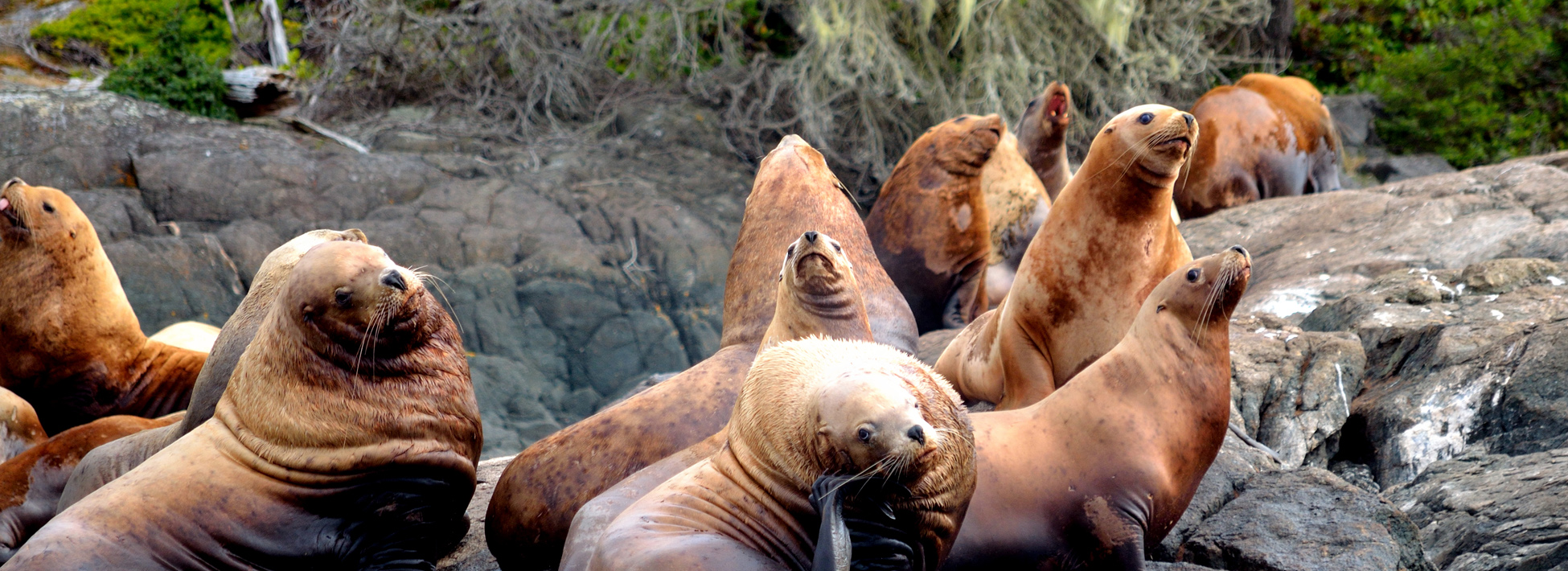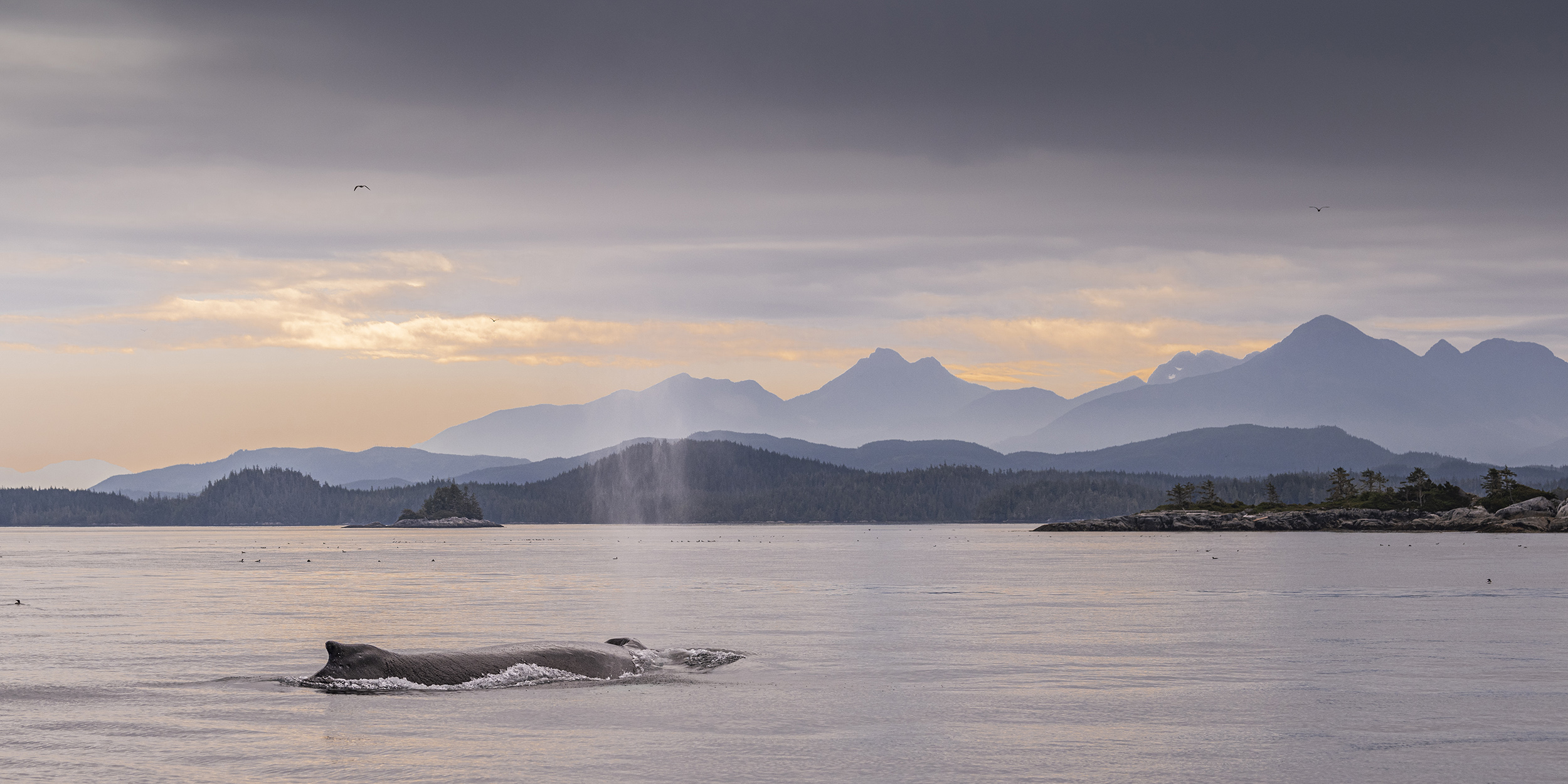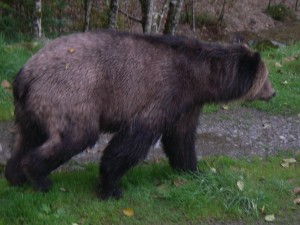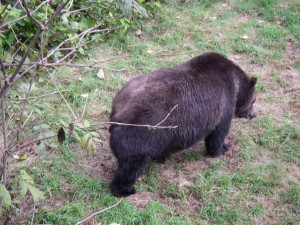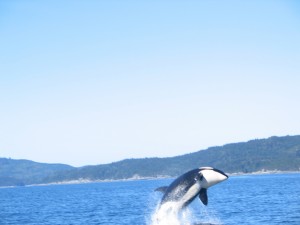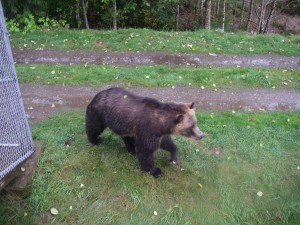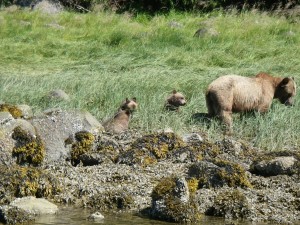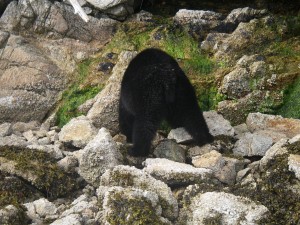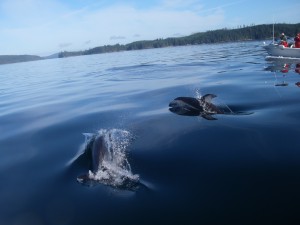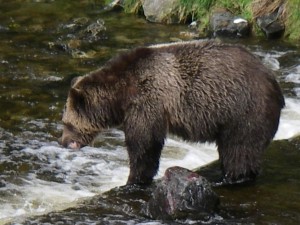The day whale watching means we travel to the area of Johnstone Strait near Telegraph Cove on Vancouver Island BC. The resident, salmon eating orca, arrive in early late June and stay through October while the transient, mammal eating orca are in the area all year. Confused? The first serious study of the orca populations in the mid-1970’s started as a summer study so when the scientist arrived in July and left in September the orca were always in the area and therefore there named resident orca. Little did they know that this was a summer feeding area as the orca followed the salmon? The transient orcas, which were in the area, spend more time in the remote inlets in the summer because there was more boat traffic. The transient orca still travel through our viewing area in the summer but this photo is of a resident as determined by the size and shape of its dorsal fin, taller and narrower at the base. Photo provide by guest Alferd Bittner.
Grizzly Bear and Wildlife Tour Blog
We offer an exceptional fly-in lodge for Grizzly Bear Watching and Whale Watching in British Columbia.
Learn about What’s happening at the Lodge, view our British Columbia’s Wildlife Report, read our Grizzly Bear Watching Blog and Whale Watching Blog. Learn more about a Day on the River Blog, see Our Tour Guide’s Photos & Blog and Photos from Our Guests.
Grizzly Bear Identification Knight Inlet
Another day another grizzly bear close to the viewing stands. No I am not trying to pass yesterdays post off as a different bear this one has a leaf on it’s back. Actually if you look at the shoulder you will notice this bear does not have the light patches on the fur on it’s neck or behind the shoulder. Coat colours and a variety of colour patches on their body identify the bears in our viewing area. Unlike bears in other areas in BC or Alaska our bears are nearly scar free. There is sufficient food that they do not fight enough to hurt or leave scars rather they just get aggressive enough to move bears to another part of the river.
Grizzly Bear Under Viewing Stand
 A day trip from the lodge means we travel up Knight Inlet to the Glendale River. In the fall the viewing time in the stands for Grizzly Bear Lodge is from 10:00 am to 12:00 am. The stands being a 20-minute van ride up a logging road, which parallels the river. The grizzly bears have accepted our presence and tend to ignore the stands and will pass close and even under the stands. The key is no flashes on cameras, no perfumes or other scents on the watchers, definitely no food, talking in quite voices and no sudden moves. Although the bears ignore if we overstep the guidelines they will turn in our direction and stare to let us know “they know”.
A day trip from the lodge means we travel up Knight Inlet to the Glendale River. In the fall the viewing time in the stands for Grizzly Bear Lodge is from 10:00 am to 12:00 am. The stands being a 20-minute van ride up a logging road, which parallels the river. The grizzly bears have accepted our presence and tend to ignore the stands and will pass close and even under the stands. The key is no flashes on cameras, no perfumes or other scents on the watchers, definitely no food, talking in quite voices and no sudden moves. Although the bears ignore if we overstep the guidelines they will turn in our direction and stare to let us know “they know”.
Whale Watching day with orca breaching
These photos are not as good as my guests as I was using a small Pentax Opti 6.0 megapixels and running the boat – that is my excuse. But I remember the day in Johnstone Strait off the shore of Vancouver Island we came upon an adult orca that seemed to be teaching a younger orca about breaching. The adult would breach and in less than a minute the younger would do the same. As you can see there were no other boats in the area and this behaviour continued for fifteen or twenty minutes must have been more than a dozen sets of breaching. As a guide we experience many interesting every summer but this ranks in the top ten for me.
Grizzly Bear close to viewing stands
The metal cage on the right side of the photo is the entrance to one of the viewing stands located on Knight Inlet’s Glendale River. We are in the stands from August 25 to mid-October and that is a “safe” place to be when the grizzly bears are coming that close. The bears have adjusted to our presence and will pass close to and underneath the stands. The river, which contains the salmon the bears are catching, is down the height of the viewing stands (3 meters or 9 feet) and out another ten to fifteen meters. A good telephoto lens is nice but not a necessity.
A Whale Watching Safari Bonus
Breaching humpback whales may occur two or three times a week but pictures are much rarer maybe once or twice a summer. In the area of Bold Head in Blackfish Sound near Telegraph Cove on Vancouver Island there are quite a few humpback whales. It is common to see six to ten whales each safari as the area has an abundance of herring, which is one of the whale’s main foods. The humpback whales arrive in late May to early June and remain in the area through October.
Knight Inlet and Spring Grizzly Bears
Knight Inlet’s Glendale River estuary is our normal viewing area for grizzly bears in the spring. The salmon have not arrived so one of the main source of food in the protein rich sedge grass which grows at the river mouth. Mother grizzly bears and cubs, in this case by their size they are last years cubs, come to the area for the sedge grass. At lower tides when the beach is exposed they turn over rocks for the high protein food of crabs, clams, barnacles, amphipods and other tiny invertebrates. These grizzlies remain in the area until the salmon arrive in August and then move up the river and we follow them to the viewing stands on the river.
Knight Inlet Black Bear Watching
This is not an uncommon pose to a black bear or even for a grizzly bear. Bears are on the beach in the spring because plant food is relatively scarce during spring and bears will continue to loose weight until well into June. Plant foods make up the majority of a bear’s diet (sometimes, as much as 90%). The black bears are kept from the salmon rivers by the grizzly bears so the beaches remain one of their main sources of protein all year. I believe
this “back to us pose” is because the beach slopes down to the water line and it is easier to roll rocks downhill.
Pacific white-sided dolphins – Whale Watching
Pacific white-sided dolphins are only one of the many mammals often viewed on the whale watching day. Dolphins tend to travel in pods of several hundred the largest pod I have come across was between fifteen hundred and two thousand. This was in the late fall and they appeared to be heading out of the area. The pods we encounter in the summer are playful and come to our boats out of curiosity. In this case we were stationary as the dolphins were following another of our boats. At other times they will pass beneath our bow while we move along side a large pod.
Signs of Grizzly Bear success
This grizzly bear is guarding a good fishing location. Look close at the large rock and notice the salmon blood. It is always nice to have a table close when you are catching food and need to eat it on site. Being able to place the salmon on the rock and eat the best parts always speed up the process and then back to fishing. The best parts depend on the individual grizzly bear and time in the fishing season. The best could be the head for mineral content, eggs and belly high in protein, or the skin with it’s layer of fat. Many bears devour the whole salmon early in the fishing season and then become more selective once they have reached a certain size, which means a successful hibernation.
